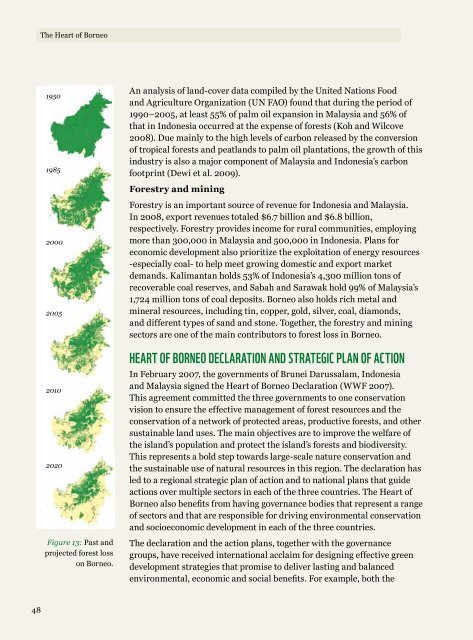Download the pdf - Global Footprint Network
Download the pdf - Global Footprint Network
Download the pdf - Global Footprint Network
You also want an ePaper? Increase the reach of your titles
YUMPU automatically turns print PDFs into web optimized ePapers that Google loves.
48<br />
The Heart of Borneo<br />
1950<br />
1985<br />
2000<br />
2005<br />
2010<br />
2020<br />
Figure 13: Past and<br />
projected forest loss<br />
on Borneo.<br />
An analysis of land-cover data compiled by <strong>the</strong> United Nations Food<br />
and Agriculture Organization (UN FAO) found that during <strong>the</strong> period of<br />
1990–2005, at least 55% of palm oil expansion in Malaysia and 56% of<br />
that in Indonesia occurred at <strong>the</strong> expense of forests (Koh and Wilcove<br />
2008). Due mainly to <strong>the</strong> high levels of carbon released by <strong>the</strong> conversion<br />
of tropical forests and peatlands to palm oil plantations, <strong>the</strong> growth of this<br />
industry is also a major component of Malaysia and Indonesia’s carbon<br />
footprint (Dewi et al. 2009).<br />
Forestry and mining<br />
Forestry is an important source of revenue for Indonesia and Malaysia.<br />
In 2008, export revenues totaled $6.7 billion and $6.8 billion,<br />
respectively. Forestry provides income for rural communities, employing<br />
more than 300,000 in Malaysia and 500,000 in Indonesia. Plans for<br />
economic development also prioritize <strong>the</strong> exploitation of energy resources<br />
-especially coal- to help meet growing domestic and export market<br />
demands. Kalimantan holds 53% of Indonesia’s 4,300 million tons of<br />
recoverable coal reserves, and Sabah and Sarawak hold 99% of Malaysia’s<br />
1,724 million tons of coal deposits. Borneo also holds rich metal and<br />
mineral resources, including tin, copper, gold, silver, coal, diamonds,<br />
and different types of sand and stone. Toge<strong>the</strong>r, <strong>the</strong> forestry and mining<br />
sectors are one of <strong>the</strong> main contributors to forest loss in Borneo.<br />
heARt oF BoRneo DeCLARAtIon AnD stRAtegIC PLAn oF ACtIon<br />
In February 2007, <strong>the</strong> governments of Brunei Darussalam, Indonesia<br />
and Malaysia signed <strong>the</strong> Heart of Borneo Declaration (WWF 2007).<br />
This agreement committed <strong>the</strong> three governments to one conservation<br />
vision to ensure <strong>the</strong> effective management of forest resources and <strong>the</strong><br />
conservation of a network of protected areas, productive forests, and o<strong>the</strong>r<br />
sustainable land uses. The main objectives are to improve <strong>the</strong> welfare of<br />
<strong>the</strong> island’s population and protect <strong>the</strong> island’s forests and biodiversity.<br />
This represents a bold step towards large-scale nature conservation and<br />
<strong>the</strong> sustainable use of natural resources in this region. The declaration has<br />
led to a regional strategic plan of action and to national plans that guide<br />
actions over multiple sectors in each of <strong>the</strong> three countries. The Heart of<br />
Borneo also benefits from having governance bodies that represent a range<br />
of sectors and that are responsible for driving environmental conservation<br />
and socioeconomic development in each of <strong>the</strong> three countries.<br />
The declaration and <strong>the</strong> action plans, toge<strong>the</strong>r with <strong>the</strong> governance<br />
groups, have received international acclaim for designing effective green<br />
development strategies that promise to deliver lasting and balanced<br />
environmental, economic and social benefits. For example, both <strong>the</strong>

















